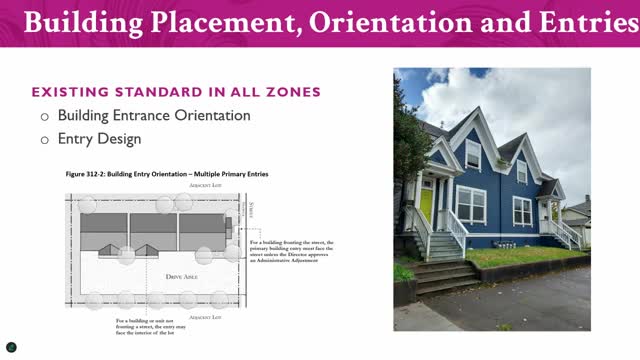Eureka reviews zoning code to update building standards and enhance urban design
December 17, 2024 | Eureka, Humboldt County, California
This article was created by AI summarizing key points discussed. AI makes mistakes, so for full details and context, please refer to the video of the full meeting. Please report any errors so we can fix them. Report an error »

The Eureka City Council meeting on December 17, 2024, focused on proposed updates to the city's zoning code, particularly regarding building design and placement standards. The discussions highlighted the need for clearer guidelines to enhance urban aesthetics while balancing development costs and housing needs.
One of the primary topics was building placement and orientation. Currently, the zoning code includes standards for mixed-use zones but lacks specific guidelines for residential areas. Council members discussed the importance of establishing standards that would ensure new buildings align with existing structures, particularly in residential neighborhoods. This would help maintain the character of the community and promote a cohesive streetscape.
Parking and vehicle access were also significant points of discussion. The existing code prohibits parking between buildings and street-facing property lines, fostering a pedestrian-friendly environment. However, there is a recognized gap in standards for parking structures and loading docks, particularly in mixed-use zones. The council considered the potential for new standards that would govern the design of parking garages, ensuring they contribute positively to the urban landscape rather than detracting from it.
Building massing standards were reviewed, with current regulations requiring setbacks for upper levels adjacent to neighboring properties. However, there is a lack of guidelines for larger buildings, which could lead to visual monotony. The council discussed the possibility of introducing standards that would require larger buildings to incorporate design features that break up their mass, enhancing visual interest and compatibility with surrounding structures.
The meeting also addressed the need for improved pedestrian and bicycle infrastructure. While the zoning code includes some standards for sidewalks and street trees, there is a lack of requirements for internal pedestrian circulation within larger developments. The council acknowledged that establishing direct connections between building entries and surrounding amenities could significantly enhance accessibility and encourage walking and cycling.
Open space requirements were another critical topic. Currently, there are no mandates for private or common open spaces in residential developments, which can hinder community interaction and quality of life. The council considered the potential benefits of requiring open spaces in larger developments to provide residents with recreational areas and promote community engagement.
Finally, the council discussed facade and roof design standards. While there are existing guidelines for exterior materials and blank wall limitations, the need for more comprehensive standards was emphasized. This could ensure that new developments meet community expectations for aesthetic quality and contribute positively to the urban environment.
In conclusion, the Eureka City Council's discussions on December 17 underscored the importance of updating zoning codes to reflect contemporary urban design principles. The proposed changes aim to enhance the visual appeal of the city while addressing practical concerns related to housing affordability and development costs. As the council moves forward, balancing these objectives will be crucial in shaping Eureka's future urban landscape.
One of the primary topics was building placement and orientation. Currently, the zoning code includes standards for mixed-use zones but lacks specific guidelines for residential areas. Council members discussed the importance of establishing standards that would ensure new buildings align with existing structures, particularly in residential neighborhoods. This would help maintain the character of the community and promote a cohesive streetscape.
Parking and vehicle access were also significant points of discussion. The existing code prohibits parking between buildings and street-facing property lines, fostering a pedestrian-friendly environment. However, there is a recognized gap in standards for parking structures and loading docks, particularly in mixed-use zones. The council considered the potential for new standards that would govern the design of parking garages, ensuring they contribute positively to the urban landscape rather than detracting from it.
Building massing standards were reviewed, with current regulations requiring setbacks for upper levels adjacent to neighboring properties. However, there is a lack of guidelines for larger buildings, which could lead to visual monotony. The council discussed the possibility of introducing standards that would require larger buildings to incorporate design features that break up their mass, enhancing visual interest and compatibility with surrounding structures.
The meeting also addressed the need for improved pedestrian and bicycle infrastructure. While the zoning code includes some standards for sidewalks and street trees, there is a lack of requirements for internal pedestrian circulation within larger developments. The council acknowledged that establishing direct connections between building entries and surrounding amenities could significantly enhance accessibility and encourage walking and cycling.
Open space requirements were another critical topic. Currently, there are no mandates for private or common open spaces in residential developments, which can hinder community interaction and quality of life. The council considered the potential benefits of requiring open spaces in larger developments to provide residents with recreational areas and promote community engagement.
Finally, the council discussed facade and roof design standards. While there are existing guidelines for exterior materials and blank wall limitations, the need for more comprehensive standards was emphasized. This could ensure that new developments meet community expectations for aesthetic quality and contribute positively to the urban environment.
In conclusion, the Eureka City Council's discussions on December 17 underscored the importance of updating zoning codes to reflect contemporary urban design principles. The proposed changes aim to enhance the visual appeal of the city while addressing practical concerns related to housing affordability and development costs. As the council moves forward, balancing these objectives will be crucial in shaping Eureka's future urban landscape.
View full meeting
This article is based on a recent meeting—watch the full video and explore the complete transcript for deeper insights into the discussion.
View full meeting
